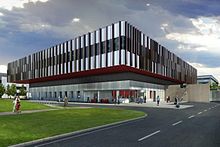Centre for Regenerative Medicine
 From Wikipedia the free encyclopedia
From Wikipedia the free encyclopedia
 An artist's impression of the Centre for Regenerative Medicine | |
| Established | 2008 |
|---|---|
| Focus | Regenerative treatment |
| Director | Stuart Forbes |
| Staff | 300 (2019)[1] |
| Key people | |
| Location | |
| Website | www |
The Centre for Regenerative Medicine (CRM) is a stem cell research centre at the University of Edinburgh in Scotland, dedicated to the study and development of new regenerative treatments for human diseases.[2] The centre forms part of the university's Institute for Regeneration and Repair and is part of the BioQuarter cluster at Little France.[3][4]
History[edit]
The University of Edinburgh's history in stem cell research dates back to the early 1990s. Under the leadership of Austin Smith, the university's Centre for Genome Research became the first Institute of Stem Cell Research (ISCR) in the UK.[5] The CRM was formed in 2008 as a merger of ISCR scientists with scientists from the University's College of Medicine and Veterinary Medicine, an initiative directed by Ian Wilmut. From 2008 to 2020, the centre had MRC status.[6] Charles ffrench-Constant became the 2nd Director of CRM in 2010; he was succeeded by Stuart Forbes in 2015.[7]
As of 2016[update], the CRM had attracted £55 million in research funding.[6]
Research[edit]
The centre is home to 26 research groups; group leaders include Clare Blackburn, Ian Chambers, Charles ffrench-Constant, Stuart Forbes, Dónal O'Carroll and Ian Wilmut.[8] As of 2019[update], the CRM employs 300 scientists.[1] Conditions being researched at the CRM include multiple sclerosis and heart and liver disease.[9][10][11] On 25 August 2014, the centre grew the first working organ, a thymus, from scratch inside an animal.[12][13] In 2019, the centre published the first in-human trial of a macrophage therapy for liver cirrhosis.[1][14]
CRM building[edit]
The CRM building was officially opened by the Princess Royal on 28 May 2012.[15] Designed by Sheppard Robson, the building is part of a total £600 million joint investment in stem cell biology and medicine by the Scottish Government and the University of Edinburgh.[16]
The CRM building is also home to applied scientists working with the Scottish National Blood Transfusion Service and Roslin Cells.[16] It contains laboratory and support space, a company incubator unit, and a clinical translation unit which enables the production of cells at Good Manufacturing Practice (GMP) grade. CRM spinout companies include Cellinta (developing gene therapies for cancer)[17][18] and Resolution Therapeutics (developing cell treatments for liver damage).[19][20]
See also[edit]
References[edit]
- ^ a b c Morton, Robin (23 December 2019). "Celebrating ten years of the MRC Centre for Regenerative Medicine". mrc.ukri.org. Retrieved 25 August 2020.
- ^ "Centre for Regenerative Medicine". The University of Edinburgh. Retrieved 25 August 2020.
- ^ "Institute for Regeneration and Repair". The University of Edinburgh. Retrieved 25 August 2020.
- ^ "World Leading Academics, Businesses, Clinicians". Edinburgh Bioquarter. Retrieved 25 August 2020.
- ^ "History of CRM". The University of Edinburgh. Retrieved 25 August 2020.
- ^ a b "BiGGAR Economics Evaluation of the Scottish Centre for Regenerative Medicine" (PDF). Retrieved 25 August 2020.
- ^ "New Director". The University of Edinburgh. Retrieved 25 August 2020.
- ^ "Research". The University of Edinburgh. Retrieved 25 August 2020.
- ^ "Multiple sclerosis". The University of Edinburgh. Retrieved 25 August 2020.
- ^ "Heart disease". The University of Edinburgh. Retrieved 25 August 2020.
- ^ "Liver disease and cancer". The University of Edinburgh. Retrieved 25 August 2020.
- ^ Bredenkamp, Nicholas; Ulyanchenko, Svetlana; O'Neill, Kathy Emma; Manley, Nancy Ruth; Vaidya, Harsh Jayesh; Blackburn, Catherine Clare (2014). "An organized and functional thymus generated from FOXN1-reprogrammed fibroblasts". Nature Cell Biology. 16 (9): 902–908. doi:10.1038/ncb3023. PMC 4153409. PMID 25150981.
- ^ Freeman, David (25 August 2014). "Scientists Create Working Organ From Scratch For First Time Ever". Huffington Post. Retrieved 28 August 2014.
- ^ Moroni, Francesca; Dwyer, Benjamin J.; Graham, Catriona; Pass, Chloe; Bailey, Laura; Ritchie, Lisa; Mitchell, Donna; Glover, Alison; Laurie, Audrey; Doig, Stuart; Hargreaves, Emily; Fraser, Alasdair R.; Turner, Marc L.; Campbell, John D. M.; McGowan, Neil W. A.; Barry, Jacqueline; Moore, Joanna K.; Hayes, Peter C.; Leeming, Diana J.; Nielsen, Mette J.; Musa, Kishwar; Fallowfield, Jonathan A.; Forbes, Stuart J. (October 2019). "Safety profile of autologous macrophage therapy for liver cirrhosis". Nature Medicine. 25 (10): 1560–1565. doi:10.1038/s41591-019-0599-8. hdl:2164/13978. PMID 31591593. S2CID 203852760.
- ^ "Princess Royal opens Scottish Centre for Regenerative Medicine". BBC News. BBC. 28 May 2012.
- ^ a b "Scottish Centre for Regenerative Medicine". Regenerative Medicine. Health Science Scotland. Retrieved 19 September 2012.
- ^ "Cancer therapeutics biotech formation supported by Steven Pollard". The University of Edinburgh. Retrieved 8 December 2020.
- ^ Parsons, Lucy (21 September 2020). "University of Edinburgh spinout Cellinta will develop gene therapies for cancer". PharmaTimes. Retrieved 8 December 2020.
- ^ "Cell therapy spinout targets liver repair treatment". The University of Edinburgh. Retrieved 8 December 2020.
- ^ Dorsey, Kirsty. "Edinburgh University spin-out secures £26.6m to treat liver damage". HeraldScotland. Retrieved 8 December 2020.
